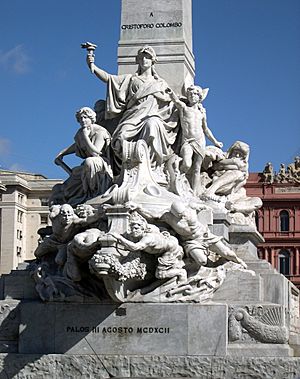Monument to Christopher Columbus (Buenos Aires) facts for kids

The Monument to Christopher Columbus was a large statue located in Buenos Aires, the capital city of Argentina. It stood in Columbus Park, right behind the government building known as the Casa Rosada. This monument was a special gift given to Argentina to celebrate 100 years of its independence from Spain in 1910.
The monument was paid for by the Italian-Argentine community, led by a successful Italian businessman named Antonio Devoto. An Italian sculptor named Arnaldo Zocchi created the statue. The first stone was laid on May 24, 1910, and the monument was officially opened on June 15, 1921.
Contents
A Gift from the Italian Community
The statue was a source of great pride for the Italian community living in Buenos Aires. They had planned it for Argentina's 100th independence celebration in 1910. For Italian immigrants, who had not always been treated with respect, sponsoring this important statue in front of the Casa Rosada helped them gain more acceptance.
Many immigrant groups, including those from Italy, Spain, France, and Germany, wanted their monuments to be placed in important locations in the capital. The spot chosen for the Columbus statue was already taken by a large fountain, which had to be moved.
What the Statue Looked Like
The statue of Columbus stood on a very tall column. Columbus himself was shown holding a map and looking out towards the sea, as if gazing towards Europe. At the bottom of the column, there were statues representing ideas like science, civilization, and genius. Other figures represented Christian faith and justice. These were meant to show the good things European culture brought to the "New World" through Columbus.
Originally, the monument's design did not directly connect Columbus to Argentina. So, the Centennial Commission asked for some changes. This led to adding carvings (called bas-reliefs) of Columbus. One showed him asking the Spanish rulers, Isabel and Ferdinand, for permission to sail west. The other showed Columbus returning, bringing enslaved native people. The monument was made of Italian marble by an Italian sculptor in Italy. Until these changes were requested, it had no direct link to Argentina or the Italian immigrant community.
After 1992, which was 500 years after Columbus's first voyage, some Argentines began to see the statue's location and meaning as a problem.
The Controversy and Moving the Statue
In 2013, the statue became a topic of big debate. President Cristina Fernández de Kirchner decided to replace the Columbus statue with one of Juana Azurduy de Padilla. Juana Azurduy was a brave revolutionary leader who fought for independence during the wars.
The new statue of Azurduy was paid for with help from Bolivian president Evo Morales. It was officially opened in July 2015. In 2013, the Columbus statue was taken apart. For two years, its pieces lay on the ground while the Azurduy statue was being built by Argentine sculptor Andrés Zerneri.
The Italian-Argentine community and many other Argentines were very upset about this change. Legal battles took place to decide where the Columbus statue should go. In 2017, it was moved to a new spot in Buenos Aires. It was placed by the waterfront on Avenida Costanera Rafael Obligado, near Aeroparque Jorge Newbery.
The two years the statue spent in pieces caused damage to its marble, so it had to be repaired. The new location also needed stronger ground to hold up the many tons of marble. The Azurduy statue was also moved in 2017 to a less central spot in Buenos Aires, in front of the Kirchner Cultural Center.
The disagreement over the Columbus and Azurduy statues shows different ideas in Argentina about history, national identity, and who gets to use public spaces.
See also
 In Spanish: Monumento a Cristóbal Colón (Buenos Aires) para niños
In Spanish: Monumento a Cristóbal Colón (Buenos Aires) para niños
- List of monuments and memorials to Christopher Columbus


